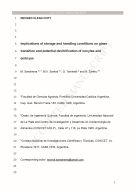Por favor, use este identificador para citar o enlazar este ítem:
https://repositorio.uca.edu.ar/handle/123456789/5495| Título: | Implications of storage and handling conditions on glass transition and potential devitrification of oocytes and embryos | Autor: | Sansiñena, Marina Julia Santos, María Victoria Taminelli, Guillermo Zaritzky, Noemí |
Palabras clave: | VITRIFICACION; EMBRIONES; NITROGENO LIQUIDO | Fecha de publicación: | 2014 | Editorial: | Elsevier | Cita: | Sansinena M, Santos MV, Taminelli G, Zaritky N. Implications of storage and handling conditions on glass transition and potential devitrification of oocytes and embryos [en línea]. Theriogenology. 2014;82(3):373–378. doi:10.1016/j.theriogenology.2014.04.003 Disponible en: https://repositorio.uca.edu.ar/handle/123456789/5495 | Resumen: | Abstract: Devitrification, the process of crystallization of a formerly crystal-free, amorphous glass state, can lead to damage during the warming of cells. The objective of this study was to determine the glass transition temperature of a cryopreservation solution typically used in the vitrification, storage and warming of mammalian oocytes and embryos using Differential Scanning Calorimetry. A numerical model of the heat transfer process to analyze warming and devitrification thresholds for a common vitrification carrier (open pulled straw, OPS) was conducted. The implications on specimen handling and storage inside the dewar in contact with nitrogen vapor phase at different temperatures were determined. The time required for initiation of devitrification of a vitrified sample was determined by mathematical modeling and compared with measured temperatures in the vapor phase of liquid nitrogen cryogenic dewars. Results indicated that the glass transition ranged from -126 to -121ºC and devitrification was initiated at -109ºC. Interestingly, samples entered rubbery state at -121ºC and therefore could potentially initiate devitrification above this value, with the consequent damaging effects to cell survival. Devitrification times were calculated considering an initial temperature of material immersed in liquid nitrogen (-196ºC) and two temperatures of liquid nitrogen vapors within the dewar (-50 and -70ºC) to which the sample could be exposed for a period of time, either during storage or upon its removal. The mathematical model indicated samples could reach glass transition temperatures and undergo devitrification in 30 seconds. Results of the present study indicate storage of vitrified oocytes and embryos in the liquid nitrogen vapor phase (as opposed to completely immersed in liquid nitrogen) poses the potential risk of devitrification. Due to the reduced time-handling period before samples reach critical rubbery and devitrification values, caution should be exercised when handling samples in vapor phase | URI: | https://repositorio.uca.edu.ar/handle/123456789/5495 | ISSN: | 0093-691X | Disciplina: | PRODUCCION AGROPECUARIA | DOI: | 10.1016/j.theriogenology.2014.04.003 | Derechos: | Acceso al texto completo del documento desde un puesto fijo de la Biblioteca Central | Fuente: | Theriogenology. 2014;82(3):373–378 |
| Aparece en las colecciones: | Artículos |
Ficheros en este ítem:
| Fichero | Descripción | Tamaño | Formato | |
|---|---|---|---|---|
| implications-storage-handling.pdf | 128,56 kB | Adobe PDF |  Visualizar/Abrir |
Visualizaciones de página(s)
168
comprobado en 30-abr-2024
Descarga(s)
155
comprobado en 30-abr-2024
Google ScholarTM
Ver en Google Scholar
Altmetric
Altmetric
Este ítem está sujeto a una Licencia Creative Commons

